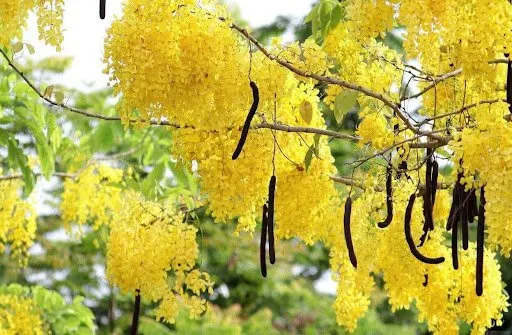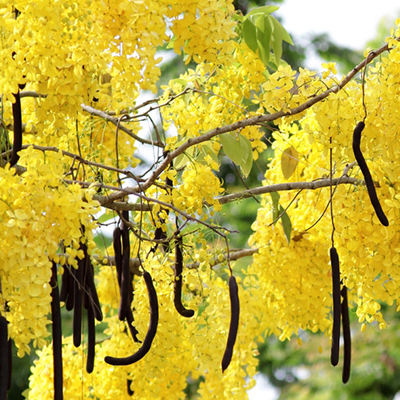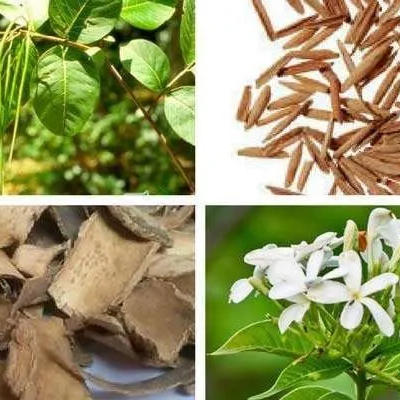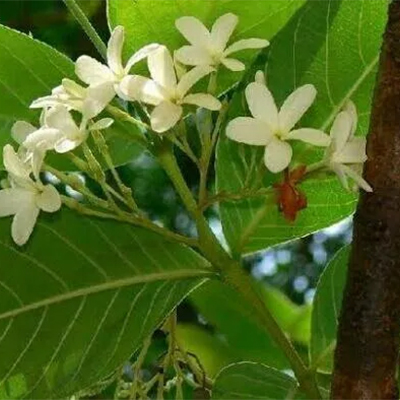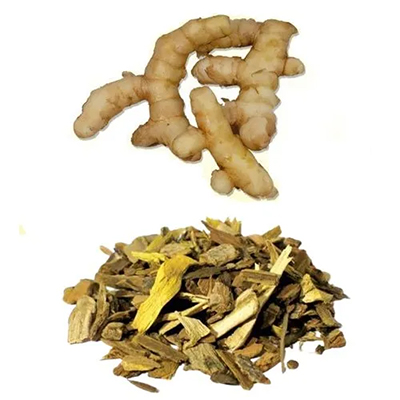On This Page
Aragvadha – The Golden Shower Tree
Introduction
Aragvadha botanically known as Cassia fistula is a plant of the family Fabaceae. Aragvadha is very famous with the name “Disease killer” as it pacifies Tridoshas i.e Vata, Pitta, Kapha. Since ancient times, Aragvadha is the drug of choice as a moderate laxative that is not only beneficial for adults but is safe even for children. In the Vedic period, no direct reference to Aaragvadha is mentioned but in Ayurvedic classical literature, Aragvadha is mentioned with more than 30 synonyms for various disorders like Vaat Rakta, Kamala, Yakrit Vikara, Swasha Vikara, etc. Raja Vriksha is a very famous synonym of Aragvadha due to its beautiful yellow color flower. Modern research revealed that Aragvadha exhibits anti-microbial, anti-fungal, anti-inflammatory, hepatoprotective, antioxidant properties, etc. due to the presence of chemical constituents like fistulic acid, sennoside A, and B. These pharmacological activities of Aragvadha makes it the drug of choice for various disorders like constipation, convulsion, pimples, hematuria, cancer, tumors of abdomen, etc.
Basonym of Aragvadha
आ समन्ताद् रुजां वधो अत्र।
Aragvadha means the herb that completely cures ailments.
Synonyms of Aragvadha
- According to morphology:
कृत माल- कृता धारिता माला पुष्पाणामनेन।
When flowering, the tree of Aragvadha looks adorned with garland.
चतुर अङ्गुल – चतस्त्रो अङ्गुल्य: प्रमाणस्य पर्वण: चतुर अङ्गुल मितानि फल मज्ज पर्वणी इत्यर्थः ।
Fruit of Aragvadha has depression at every four-inch distance.
दीर्घ फलः – दीर्घं फलं यष्टि वदस्य।
Its fruits are long.
राज वृक्ष: – वृक्षाणां राज सुमनः शेखर त्वात्।
Aragvadha is regarded as the king of trees owing to its beauty.
सवर्णांग – स्वर्ण वरना अन्य अंगानि पुष्पाणया यस्य।
The flowers are golden yellow.
प्रग्रह: – प्रकर्षेण गृह्यते जनैः।
Liked by people as it is beautiful.
- Synonyms according to properties and action.
आमहा – आमं हन्ति।
Aragvadha relieves Ama.
आरेवत – आरेवयती नि: सारयति मलम।
Aragvadha expels Mala (feces) from the body.
आरोग्य शिम्बी – आरोग्यप्रद: शिम्ब: फलमस्य।
Pods are therapeutically very useful.
कुष्ठ सूदन – कुलथम सुदितीति।
Cures skin diseases.
ज्वारांतक: – ज्वर नाशक: ।
Relieves from fever.
व्याधिघात: – व्याधीन हन्ति।
Useful in many diseases.
शम्पाक: – शं कल्याणकारी पाको अस्य।
Corrects the digestive process.
- Other synonyms
कर्ण भरण – कर्णयोरा भरण रूपेण प्रयुज्यते।
Flowers were used as ear ornaments.
Regional Names of Apamarga
- Purging Cassia (English)
- Amaltas (Hindi)
- Kakki Kayi, Phalus (Kannada)
- Konna, Kanikonna (Malayalam)
- Bawa, Bahva (Marathi)
- Garmalo (Gujrati)
- Kondrem (Tamil)
- Rela (Telugu)
Botanical Name
Cassia fistula Linn.
Cassia is derived from the Greek, Hebrew word Kasia means the name of the plant.
Fistula refers to the cylindrical pod or tube
Family
Caesalpinaceae / * Fabaceae (Puti Karanja Kula)
Ayurveda Reference for Aragvadha (Cassia Fistula)
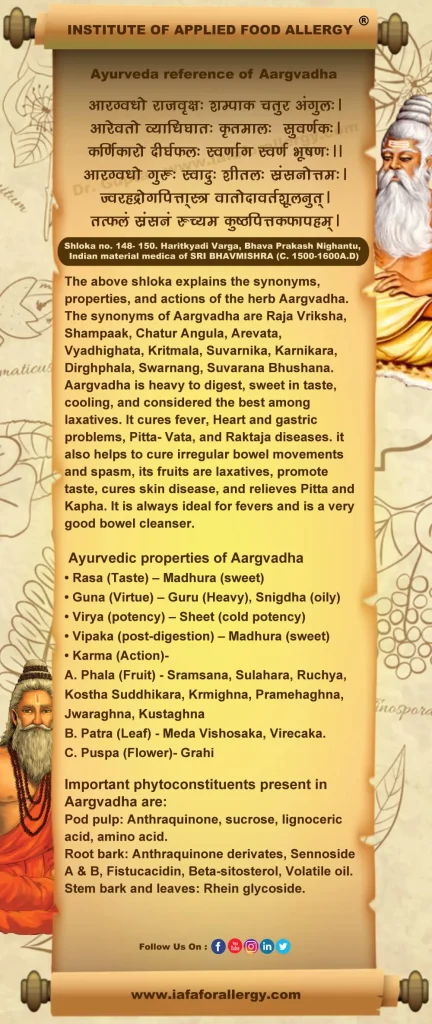
Scientific Classification of Aragvadha
| Kingdom | Plantae |
| Class | Dicotyledons |
| Subclass | Polypetalae |
| Series | Thalamiflorae |
| Order | Parietales |
| Family | Caesalpinaceae (*Fabaceae) |
| Genus | Cassia |
| Species | fistula |
Classification of Aragvadha (Cassia Fistula) – As Per Charaka and Sushruta
- Charaka: Kusthaghana Mahakshaya, Kandughana Mahakshaya, Tikat Skandha
- Sushruta: Aragvadhadi Gana, Shyamadi Gana, Adhho- Bhagahara Dravya.
Aragvadha’s Description in Brihtrayi
| Charaka | Shusruta | Vagbhata
(Ashtang Hridya) |
| C. S. Su. 1/ 82, 85 | S. S. Su. 11/ 11 | A. H. Su. 15/ 7, 17 |
| C. S. Su. 2/ 9 | S. S. Su. 38/ 5 | A. H. Su. 19/ 58 |
| C. S. Su. 3/ 2 | S. S. Su. 39/ 9 | A. H. Chi. 1/ 60, 64, 101, 143 |
| C. S. Su. 4/ 13 | S. S. Su. 42/ 18 | A. H. Chi. 5/ 52 |
| C. S. Su. 23/ 9, 11 | S. S. Su. 44/ 84 | A. H. Chi. 6/ 18 |
| C. S. Vi. 8/ 143 | S. S. Chi. 1/ 78 | A. H. Chi. 12/ 41 |
| C. S. Chi. 3/ 203, 231, 244 | S. S. Chi. 4/ 30 | A. H. Chi. 13/ 6 |
| C. S. Chi. 4/ 56 | S. S. Chi. 5/ 10 | A. H. Chi. 15/ 63 |
| C. S. Chi. 7/ 90, 96, 159 | S. S. Chi. 8/ 30 | A. H. Chi. 16/ 1, 41 |
| C. S. Chi. 13/ 70 | S. S. Chi. 9/ 5, 7, 8, 28, 34, 49 | A. H. Chi. 17/ 33 |
| C. S. Chi. 15/ 179 | S. S. Chi. 10/ 4, 6, 7, 8, 9, 10 | A. H. Chi. 18/ 16 (2) |
| C. S. Chi. 16/ 57 | S. S. Chi. 11/ 7, 8 | A. H. Chi. 19/ 13, 59 |
| C. S. Chi. 18/ 110 | S. S. Chi. 12/ 9 | A. H. Ka. 1/ 25 |
| C. S. Chi. 21/ 88, 89 | S. S. Chi. 16/ 24 | A. H. Ka. 4/ 7, 17, 37 |
| C. S. Chi. 26/ 56, 134 | S. S. Chi. 17/ 44 | A. H. U. 20/ 8 |
| C. S. Chi. 27/ 26, 32 | S. S. Chi. 18/ 13, 33 | A. H. U. 25/ 41, 65 |
| C. S. Ka. 1/ 25 | S. S. Chi. 19/ 35, 39 | A. H. U. 32/ 5 |
| C. S. Ka. 8 (Whole Chapter) | S. S. Chi. 20/ 39 | A. H. U. 34/ 57 |
| C. S. Ka. 10/ 13 | S. S. Chi. 23/ 14 | A. H. U. 36/ 88 |
| C. S. Si. 3/ 37, 54 | S. S. Chi. 25/ 22 | |
| C. S. Si. 27/ 31 | S. S. Chi. 37/ 13, 33 | |
| S. S. Chi. 38/ 59, 70, 78, 105 | ||
| S. S. Ka. 5/ 54, 85 | ||
| S. S. Ka. 7/ 14, 28 | ||
| S. S. U. 39/ 117, 268, 307 | ||
| S. S. U. 42/ 37 | ||
| S. S. U. 44/ 16, 49, 23 | ||
| S. S. U. 57/ 14 | ||
| S. S. U. 61/ 30 |
External Morphology of Aragvadha
- Habit – Aragvadha is a medium-sized perennial tree.
- Stem – erect, branched, cylindrical, woody, solid, bark greenish-grey in color.
- Leaf – Leaves of Aragvadha are alternate, petiolate, compound, and paripinnate, with pulvinus at the base. Leaflets are in 4- 8 pairs, stalked, ovate, wavy, acute, glabrous, entire, venation of the leaflets unicostate, reticulate.
- Inflorescence – Long axillary pendulous racemes.
- Flower – Pedicellate, with long pedicels, bracteate, bisexual, complete, zygomorphic, yellow, hypogynous, and pentamerous.
- Calyx – 5 sepals, slightly petaloid, polysepalous, odd sepal anterior, imbricate aestivation.
- Corolla – 5 petals, the polypetalous, yellow, posterior petal is small and innermost in the bud, petals unequally inserted on the thalamus.
- Androecium – 10 stamens, polyandrous and all with anthers, but very unequal in length.
- Gynoecium – Monocarpellary, ovary superior, unilocular, with marginal placentation, ovules many, short style, stigma is terminal and hairy.
- Fruit – A very long legume (1-2 feet) and cylindrical (nearly one inch in diameter).
- Seeds – Flat, albuminous, embedded in soft pulp.
Flowering and Fruiting Time of Aragvadha
Flowering in March-May and fruiting of Aragvadha occur in May.
Controversy Regarding Aragvadha
Since Dhanvantari and Raja Nighantus quote two varieties of Aragvadha:
- Aragvadha
- Karnikara
Arevata has become one of the controversial plants. Bhagiratha Swami explains that where Arevata is in masculine gender it should be taken as Aragvadha and when it is in neutral gender it should be taken as Palevata. Bapalalji points out that Arevata is not described by Charaka among the fruits, but Paravata is mentioned. Both these are absent in Amarakasa. These terms are however used in Dhanvantari Nighantu. Chakrapani in this context quoted that Paravata is Known in Assam and Burma regions. Therefore, it may be identified as Garcinia mangostana. The synonym Tamala given for the Aragvadha variety by Dhanvantari Nighantu justifies the identity. Though some consider Guava fruit (Psidium guajava Linn.) as Palevatam, it is to be identified as ‘Perukam’ according to Nighantu Ratnakara.
Different Varieties of Aragvadha
In Dhanvantari Nighantu Aaragvadha and Karnikara have been mentioned as two different varieties. The same opinion is expressed in Raja Nighantu also.
Vagbhata had described two varieties of Palevatam viz., Madhura (sweet) and Amla (sour) varieties (AH. Su. 6/ 135)
Distribution of Aragvadha
Cassia fistula is found throughout India in dry deciduous and moist deciduous forests. The tree is also distributed in Sri Lanka, Southeast Asia, and Tropical Africa. Also, Aragvadha is planted in the old and new world’s tropics.
The Useful Part of Aragvadha
Fruit pulp, roots, bark, leaves
The fruit of the Aragvadha is a straight or slightly curved, cylindrical pod of chocolate brown color, with a short woody stalk and a blunt end that is suddenly contracted into a point. It measures 40 to 70 cm in length and up to 2.5 cm in diameter. Internally the pod is divided into several cellular compartments by then Woody transverse dissepiments. These compartments contain flat, oval seeds of reddish-brown color and a soft black greasy pulp. Commercially available material consists of seeds and walls of cells, having deposits of black pulp. Pieces of the rind are also commonly mixed with the mixture.
Important Phytoconstituent of Aragvadha
- Pod pulp: Anthraquinone, sucrose, lignoceric acid, amino acid.
- Root bark: Anthraquinone derivatives, Sennoside A & B, Fistucacidin, Beta-sitosterol, Volatile oil.
- Stem bark and leaves: Rhein glycoside.
Recent Research on Aragvadha
- Antipyretic
- Antiviral
- Anti-bacterial
- Anti-inflammatory
- Wound healing property
- Hepatoprotective
- Antitussive
- Laxative
- Anti-tumor
- Anti-parasitic
- Antidiabetic
- Antifertility
Rasa Panchaka of Aragvadha
Rasa-Panchaka (Properties) of Aragvadha Phala Majja (Pulp)
| Rasa (Taste) | Madhura (sweet), Tikat (bitter) |
| Guna (Virtue) | Guru (heavy), Snigdha (oily) |
| Virya (potency) | Sheet (cold potency), Ushana (hot potency) by Dhanwantri Nighantu |
| Vipaka (post-digestion) | Madhura (sweet) |
Rasa-Panchaka (Properties) of Aragvadha Puspa flowers)
| Rasa (Taste) | Madhura (sweet), Kashaya (astringent), Tikat (bitter) |
| Guna (Virtue) | |
| Virya (potency) | Sheet (cold potency) |
| Vipaka (post-digestion) | Madhura (sweet) |
Rasa-Panchaka (Properties) of Karnikara variety
| Rasa (Taste) | Madhura (sweet), Tikat (bitter) (Raja Nighantu) |
| Guna (Virtue) | Laghu (light), Sara (mobility) |
| Virya (potency) | Sheet (cold potency), Ushana (hot potency) by Raja Nighantu |
| Vipaka (post-digestion) | Madhura (sweet), Raj Nighantu- Katu (pungent) |
Dosa karma
Vata – Pitta Shamaka and Pitta Kapha Samsodhaka.
- Vata Shamaka because of Madhura Rasa, Snigdha Guna and Madhura Vipaka.
- Pitta Shamaka because of Madhura Rasa and Sheeta Virya.
- Pitta Kapha, Samsodhaka because of its Sramsana property.
Karma (Actions) of Aragvadha
- Phala (Fruit) – Sramsana, Sulahara, Ruchya, Kostha Suddhikara, Krmighna, Pramehaghna, Jwaraghna, Kustaghna
- Patra (Leaf) – Meda Vishosaka, Virecaka.
- Puspa (Flower) – Grahi
Aragwadha phala majja is best Sramsaka.
Prayogarha Vyadhi (Therapeutic Indication) of Aragvadha
- Phala (Fruit) – Hrid Roga, Jwara, Udavarta, rakta- Pitta, Kustha, Krimi Roga, parmeha, Gulma, Udara Roga, Vrana, Mutra kriccha.
- Patra (Leaf) – Medoroga.
Aamyik Paryog (Therapeutic Uses) of Aragvadha
Jvara (Fever):
- One afflicted with fever should take Aragvadha with milk or grape juice. (Charaka Samhita Chikitsa Sthana. 3/ 232)
- Aragvadha, due to Mridu, Madhura, and Sheeta’s properties, is efficacious, particularly in fever, cardiac disorders, Vataarakta, Udavartta, etc. Because of its being mild and free from complications it is fit to be used particularly in children, old and delicate people, and those having wounds and emaciation. (Charaka Samhita Kalpa Sthana. 8/ 45)
Kamala (Jaundice): Aragvadha, in the dose of 40 gm, should be taken with the juice of sugarcane, Vidari or Amalaka added with Trikatu. It alleviates jaundice. (Ashtanga Hridya Chikitsa Sthana. 16/ 41)
Prameha (Diabetes): Decoction of Aragvadha is efficacious in Haridrameha. (Shusruta Samhita Chiktsa Sthana. 11/ 9)
Kustha (Skin disorder):
- Leaves of Aragvadha, Kakamachi, and Karanja are pounded with buttermilk and applied as an ointment after smearing with oil the part affected with leprosy (or skin diseases). (Charaka Samhita Sutra Sthana. 3/ 17)
- Decoction of Daruharidra, Rasanjana, Nimba, Patola, Khadira, Aragvadha, Kutaja, Triphala, Saptaparna, and Tinisa separately, alleviate kustha if used as bath and intake. (Charaka Samhita Chikitsa Sthana 7/ 97-98)
- Ghee is cooked with the root (bark) of Aragvadha and taken with the decoction of Khadira, it destroys leprosy. (Ashtanga Hridya Chikitsa Sthana. 19/ 13)
- Leaves of Aragvadha are pounded with sour gruel and applied on the part in the case of ringworm, Kitibha, Kustha, and Sidhma. (Vrinda Madhava. 49/ 9; also Vang Sena. Kustha. 63)
Gandamala (Cervical adenitis): Root (bark) of Aragvadha pounded with rice water is used as snuff and paste in the case of Gandamala. (Vrinda Madhava. 41/ 23)
Vrana (Wounds): Powder of Aragvadha, Haridra, and Himsra mixed with honey and ghee is made into a wick which is applied to wounds for their purification. (Shusruta Samhita Chikitsa Sthana. 8/ 30)
Amavata (Rheumatoid arthritis): Leaves of Aragvadha are fried with mustard oil and taken in the evening followed by a meal. It alleviates Ama. (Bhava Prakasha Samhita Chikitsa Sthana. 26/ 52)
Visarpa (Erysipelas): The leaves of Aragvadha, the bark of Sleshmataka, etc. should be used separately or jointly as local paste added with a little ghee. (Charaka Samhita Chikitsa Sthana. 21/ 89-92)
Urustambha (stiffness of thighs): The tender leaves of Sunisannaka, Nimba, Arka, Vetasa, and Aargavadha should be used as a vegetable cooked with water and oil and without salt. (Charaka Samhita Chiktsa Sthana. 27/ 26)
Udara Roga (GIT disorders):
In Udara Roga caused by Pitta, the patient should be purgated with milk added with the paste of Trivrit or processed with Eranda or Satala and TrayamanA or Aragvadha. (Charaka Samhita Chikitsa Sthana. 13/ 69-70)
Upadansha (Venereal diseases):
- By local application of the paste of the root of Aragvadha etc. separately pounded with water even the severe venereal disease disappears. (Gada Nigreha. 4. 8. 21)
- The (decoction of the) leaves of Karavira, Jati, Aragvadha, Tarkari, and Arka should be used for washing venereal wounds. (Shusruta Samhita Chikitsa Sthana. 19/ 39)
Kikkisa (stria gravidarum) & Abhighataj Vrana (Accidental wounds):
- The paste of the leaves of Aragvadha pounded with breast milk should be applied to the wound and Kikkisa for healing. (Vaidya Manorma. 16. 121)
Matra (Therapeutic Administration and Dosage) of Aragvadha
- Fruit-Pulp (Phala Majja) – 5-10 grams
- Decoction (Kwatha of Root – Bark) – 50-100 ml.
- Pushpa Swarasa – 5 – 10 ml
- Beeja Churna – 3- 6 gram

Have A Health Issue?
Consult Online
- Dr. Sahil Gupta (B.A.M.S., M.H.A.)
Ayurvedic Allergy Specialist
CEO & Founder of IAFA®
Classical Reference of Aragvadha
Bhava Prakasha Nighantu Haritkyadi Varga- 148
Synonyms
आरग्वधो राजवृक्ष: शम्पाक चतुर अंगुल:।
आरेवतो व्याधिघात: कृतमाल: सुवर्णक: ।
कर्णिकारो दीर्घफल: स्वर्णांग स्वर्ण भूषण: ।।
Bhava Prakasha Nighantu Haritkyadi Varga- 149- 150
Properties and Actions of Aragvadha
आरग्वधो गुरु: स्वादुः शीतल: स्रंसनोत्तम: ।
ज्वरहद्रोगपित्ता्स्त्र वातोदावर्तशूलनुत् ।
तत्फलं स्रंसनं रुच्यम कुष्ठपित्तकफापहम् ।
ज्वरे तु सततं पथ्यम कोष्ठशुद्धिकरं परम् ।।
Dhanwantri Nighantu Guduchyadi varga- 216
आरग्वधो रसे तिक्तो गुरुष्ण: कृमिशूलनुत्।
कफोदर प्रमेहघ्न: कृच्छगुल्मत्रिदोषजित्।।
Kaideva Nighantu Aushadhiadi varga, 944- 945
आरग्वधो हिमस्तिक्तो मधुरो मृदुरेचन: ।
गुरु दोषनत्रयहरो ज्वरगुल्मोद्रापह:।।
शूलोदावर्तहृद्रोग व्रण कृच्छप्रमेहनुत् । ।
Kaideva Nighantu Aushadhiadi varga, 945 – 946
आरग्वधपत्र- पत्रमारग्वधस्याणि कफमेदो विशोषणम्।
विरेके सतत पथ्य॑ मलदोष समन्विते।।
Kaideva Nighantu Aushadhiadi varga, 945- 946
आरग्वध कुसुम- कुसुमं शिशिरं स्वादु कषाय॑ भ्राहि तिक्तकम् ।
Kaideva Nighantu Aushadhiadi varga, 947
आरग्वध फल- तत्फलं स्रंसनं रुच्य॑ कुष्ठ पित्तकफापहम् ।
ज्वरे तु सतत पथ्यं कोष्ठशुद्धिकरं परम ।।
Kaideva Nighantu Aushadhiadi varga, 948
आरग्वध फल मज्जा- तन्मज्जा स्वादुपाको अग्निकृत स्निग्धो अनिलपित्तहा |
Shodhala Nighantu
आरग्वधो अतिमधुरः शीत: शूलापहारक: ।
ज्वरकण्डू कुष्ठमेह कफविष्टम्भ नाशन: ।।
Charaka Samhita Sutra Sthana. 25/ 40
चतुरअंगुल मृदुविरेचनानाम ।
Charaka Samhita Kalpa Sthana. 8/ 4, 5
ज्वरहद्रोगवातासृगुदावर्तादिरोगिषु।
राजवृक्षो अधिकं पथ्यो मृदुमधुर शीतलः।
योज्यो मृद्दनपायित्वाद्विशेषा चतुरअंगुल: ।
Charaka Samhita Kalpa Sthana. 8/ 3
चतुरअंगुल आरग्वध
आरग्वधो राज वृक्ष: शम्पाकश्चतुर अंगुलः।
प्रग्रह: कृतमालश्च कर्णिकारो अवघातक: ।।
Raja Nighantu
आरग्वधो अतिमधुर: शीत: शूलापहारक: ।
ज्वर कण्डु कुष्ठ मेह विष्टम्भं नाशनः।
Chakra Dutta
पित्त ज्वरे
द्राक्षा अखधयोर वापि।
Chakradutta, 41- 19
गण्डमालायाम
आरग्वधशिफा क्षिपं पिष्ट्वा तण्डुलवारिणा।
सम्यड्नस्यप्रलेपाभ्यां गण्डमालाहरा: परा:।।
Shodala Nighantu, Gada Nigreha 4- 8- 21
उपदंशे
……शम्पकानाम पृथक पृथक्।
मूलेन परिपिष्टेन वारिणा…… ।
असाध्यापि वज्रत्यस्तं लिंगो तथा रुक् प्रलेपनात् ।
Vaidya Manorma, 16/ 121
सद्योव्रण किक्किसे च
अकिञ्चचनानाधिकस्य पत्रं स्तन्येन संपिष्य समर्पयेद् द्राक्।
सद्यो व्रण रोपणमाशुवाज्छन् कल्कम च दद्यातथकिक्तिसस्य।।
Vrinda Madhava, 49/ 9, Vangsena, Kustha, 63
दद्रु किट्टिभ कुष्ठ
आरग्वधस्य पत्राणि धारणालेन लेपयेत्।
दद्रु किटिभ कुष्ठानि हन्ति सिध्मानमेव ।।
Bhava Parkasha Samhita Chiktsa Sthana, 26/ 53
आमवाते
आरग्वधस्य पत्राणि भृष्टानि कंटुतैलत: ।
आमघ्नानी नर: कुर्यात्सायं भक्तावृततानि च।।
Bhava Parkasha Samhita Chiktsa Sthana, Kustharogadikara, 52/ 142- 144
मनोनुकूलद्रव्यानुपाने विरेचनार्थ शम्पाक- आरग्वधस्य प्रयोग: ।
कच्छू-पामा-शीतपित्तादिविकाराणां प्रतीकारार्थम् कृतमालादिकल्कम्।
Charaka Samhita Sutra Sthana. 3/ 37
त्वक रोगे
पर्णानि पिष्ट्वा चतुर अंगुलस्य तक्रेण पर्णान्थयकाकमाच्या।
तैलाक्तगात्रस्य नरस्य कुष्ठान्युदर्ययेदाश्वहनच्छदेश्व ॥
Charaka Samhita Chiktsa Sthana. 18; 13/ 69, 70
पित्तोदरे
…….शृतेनारग्वधेन वा ।…. पित्तोदरं जयेत्।।
Charaka Samhita Chiktsa Sthana. 27- 25 (26)
उरुस्तम्भे
शाकैरलवणेरद्याज्जलतैलीयसाधितै: ।
……वेत्रारग्वधपल्वै: ।।
Charaka Samhita Chiktsa Sthana. 20/ 56, Ashtanga Hridya, 16/ 41
कामलायाम
आरग्वधं रसेनेक्षो:…..पिबेत्रा कांमलापहम्।
Charaka Samhita Chiktsa Sthana. 21/ 88 (89- 92)
विसर्पे
आरग्वधस्यापि पत्राणि……।।
पृथगालेपनं कुर्याद्दन्दश: सर्वशो अपि वा।।
Charaka Samhita Chiktsa Sthana. 3/ 227 (3- 232)
ज्वरे
आरग्वधं वा पयसा मृद्वीकानां रसेन वा।
…..पयसां पिवेज्वरित: ॥
Charaka Samhita Chiktsa Sthana. 7/ 94 (7/ 97, 98)
कुष्ठे
आरग्वधवृक्षकयो: कषाय: …..स्नाने पाने च मत: ।
Charaka Samhita Kalpa Sthana. 8/ 16
विरेचने
यस्य यत् पानमन्नं च हृद्यं स्वाद्वथवा कटु ।
लवणं वा भवेत्तेन युक्त दद्याद्विरेचनम् ।।
Shusruta Samhita Chiktsa Sthana. 19/ 39
व्रण प्रक्षालने
……पत्राणि जात्यारावधयोस्तथा ।
प्रक्षालने प्रयोज्यानि…. ।
Shusruta Samhita Chiktsa Sthana. 11/ 7
हरिद्रामेहे
हरिद्रामेहिनं राजवृक्षकषायम।
Ashtanga Hridya, Chiktsa Sthana. 19/ 13
कुष्ठ्म
आरग्वधस्य मूलेन शतकृत्य: श्रृतं घृतम्।
पिवेत्कुष्ठंजयत्याशु भजन् सखदिरं जलम्।।
Charaka Samhita Kalpa Sthana. 8
फलकाले फलं तस्य ग्राह्म॑ परिणतं च यत्।
सप्त रात्रात्समुदूधृत्य शोषयेदातमे भिषक्।
ततो मज्जानमुद्धृत्य शुचौ भाण्डे निधापयेत्।।
Charaka Samhita Chiktsa Sthana, Kalpa Sthana, 6- 7
फलकाले फलं तस्य ग्राह्म॑ परिणतं च यत्।
सप्तरात्रात् समुदूधृत्य शोषयेदातपे भिषक्।
ततो मज्जानमुदधृत्य शुचौ भाण्डे निधापयेत् ॥
Charaka Samhita Chiktsa Sthana, Kalpa Sthana, 8
बालरुग्णे
द्राक्षारसयुतं दद्याद्दाहोदावर्तपीडिते ।
चतुर्वर्षमुखे बाले यावदादशवार्षिके॥
Charaka Samhita Kalpa Sthana, 8/ 13
आरग्वधसाधितक्षीरोद्घृतम्
चतुर अंगुलसिद्धाद्वा : क्षीराद्यदुदियाद् घृतम।
मज्ज: कल्केन धात्रीनाम रसे तत्साधितं पिवेत्।।
Charaka Samhita Kalpa Sthana
आरग्वधद्यारिष्टम
दन्तीक्वाथे अंज्जली मज्ज: शम्पाकस्य गुडस्य च।
दच्वा मासार्धमासस्थमरिष्ट पाययेत च॥
Charaka Samhita Kalpa Sthana, 9- 10
आरग्वधषड्योग:
चतुर अंगुल: मज्जस्तु प्रसृत॑ वा अथवा अञ्जलिम ।
सुरामण्डेन संयुक्तमथवा कोलसी धुना।।
दधि मण्डेन वा युक्त रसेन्तामलकस्य वा।
कृत्वा शीतकषायां तं पिवेत् सौवीरकेण वा।।
Charaka Samhita Kalpa Sthana, 8- 11
आरग्वधयोगद्वयम्
त्रिवृतो वा कषायेण मज्ज: कल्कं तथा पिवेत् ।
तथा बिल्वकषायेण लवणक्षौद्रसंयुतम्।।
Charaka Samhita Chiktsa Sthana, 16- 58, 59
कफज पाण्डु रोग
आरग्वधं रसेनेक्षोर्विदार्याम॑लकस्य च।
स्त्र्युषणं बिल्वपत्रं पिवेनना कामलापहम्।।
Charaka Samhita Kalpa Sthana, 8- 12
आरग्वधाद्यवलेहः
कषायोष्णाथवा तस्य त्रिवृच्चूर्ण गुडान्वितम् |
साधयित्वा शनैरलेहं लेहयेन्मात्रया नरम्।।
Charaka Samhita Chikitsa Sthana, 50/ 7
कुष्ठचिकित्सायाम्
चतुर अंगुलः दलप्रलेप: ।
Charaka Samhita Kalpa Sthana, 8- 17- 18
आरग्वधस्य विविधयोगाः (सुकुमाररुग्णार्थ )
द्राक्षारसे सुरासीध्वोर्दघनि चामलकीरसे।
सौवीरके कषाये च त्रिवृतो बिल्वकस्य च।।
लेहे अरिष्टे घृते द्वे च योगा द्वादश कीर्तिता: ।
चतुर अंगुल कल्पे अस्मिन सुकुमारः सुखोदया:।।
Bhava Prakasha, Aam Vaata Adhikara, 26- 52
आरग्वधपत्रप्रयोग:
आरग्वधस्य पत्राणि भृष्टांनि कटुतैलत: ।
आमघ्नानी नर: कुर्यात्सायं भुक्तावृतानि च ॥
Bhava Prakasha, Updansha Adhikara, 51- 12
उपदंशे आरग्वधादिगणपरिषेचनम्
आरग्वधादिक्वाथेन परिषेकच्च दापयेत्।
Specific Formulation of Aragvadha
- Aragwadha Arishtam for Jwara, Hridroga, Vatarakta
- Aragvadhadi Avaleha for Udavarta, Hridroga
- Aragwadhadi Ghrita for Jwara, Vaat- Rakta
- Aragvadhadi Tailam for Shwitra
- Aragvadhadi Kashayam for Shool, Kamala, Raktapitta
- Mahamarichyadi Taila for Kustha, Sarvanga Shotha
- Mahamanjisthadi Kwatha for Raktapitta, Daha
- Avalgujadi Lepam
Contraindication and Side Effects of Aragvadha
- Aragvadha when used in a large dosage may cause excessive purgation.
- It is best to take Cassia fistula under medical supervision.
Suggestive Reading Regarding Aragvadha
- Agnivesha, Charaka, Dridhabala. In: Charaka Samhita, ed. Vaidya Jadavaji Trikamji Aacharya., editor. Varanasi: Chaukhamba Sanskrit Sansthan; 2009.
- Sushruta. In: Sushruta Samhita, Sutra Sthana, ed. Vaidya Jadavji Trikamji Acharya., editor. Varanasi: Choukhambha Orientalia; 2005.
- Vagbhata. In: Ashtanga Hrudaya, 9th ed. Anna Moreshwar Kunte, Krishnashastri Navarre, Harishastri, editors. Varanasi: Choukhambha Orientalia; 2005.
- Bhavamishra. In: Bhava Prakasha Nighantu, Haritkyadi Varga 11th ed. part 2. Brahma Shankara Mishra., editor. Varanasi: Choukhambha Bharati Academy; 2009.
- Bhavprakasha, commentary by Bulusu Sitaram, forwarded by K.C.Chunekar
- Sharma PV, Kaideva Nighantu. Aushadhi Varga. Chaukhamba Orientalia, Varanasi; 2006:
- Tripathi I., Raja Nighantu, Chaukhamba Krishnadas Academy; Varanasi; 2010
- Dhanwantri Nighantu, Guduchyadi Varga
- Shodhala Nighantu
- Dr. Gyanendra Pandey, Dravyaguna Vigyana, reprint 2012, Chwkhamba Krishnadas Academy
- K. Niteshwar Dravyagunavigyana, reprint 2017.
- Dr. J.L.N. Sastry and Dr. B.S. Sastry, Dravyaguna Vigyana, Chaukhambha Orientalia, Varanasi.
- Chakrapanidatta, Chakradatta with the vaidayaprabhahindi commentary by indradevatripathi, chaukambha sankritasansthan, varanai 2nd Edition, 1994.
References
- Agnivesha, Charaka, Dridhabala . In: Charaka Samhita, ed. Vaidya Jadavaji Trikamji Aacharya., editor. Varanasi: Chaukhamba Sanskrit Sansthan; 2009.
- Sushruta. In: Sushruta Samhita, Sutra Sthana, ed. Vaidya Jadavji Trikamji Acharya., editor. Varanasi: Choukhambha Orientalia; 2005.
- Vagbhata. In: Ashtanga Hrudaya, 9th ed. Anna Moreshwar Kunte, Krishnashastri Navarre, Harishastri, editors. Varanasi: Choukhambha Orientalia; 2005.
- Bhavamishra. In: Bhava Prakasha Nighantu, Guduchyadi Varga 11th ed. part 2. Brahma Shankara Mishra., editor. Varanasi: Choukhambha Bharati Academy; 2009.
- Bhavprakasha, commentary by Bulusu Sitaram, forwarded by K.C.Chunekar
- Sharma PV, Kaideva Nighantu. Aushadhi Varga. Chaukhamba Orientalia, Varanasi; 2006:
- Tripathi I., Raja Nighantu, Chaukhamba Krishnadas Academy; Varanasi; 2010
- Dr. Gyanendra Pandey, Dravyaguna Vigyana, reprint 2012, Chwkhamba Krishnadas Academy
- K. Niteshwar Dravyagunavigyana, reprint 2017.
- Priya Nighantu by P. V. Sharma, Chaukhamba Krishnadas Academy; Varanasi
- Dr. J.L.N. Sastry and Dr. B.S. Sastry, Dravyaguna Vigyana, Chaukhambha Orientalia, Varanasi.
- Chakrapanidatta, Chakradatta with the vaidayaprabhahindi commentary by indradevatripathi, chaukambha sankritasansthan, varanai 2nd Edition, 1994.
Ayurveda is an Indian system of medicine that is popular since ancient times. Dr. Gupta’s IAFA® has been conducting research studies to find out different phytoconstituents of herbs and their action in the body. Such knowledge acquired by our experts is used in the preparation of medicines and providing the treatment facilities safely and effectively. IAFA® is the provider of safe and effective treatment for a wide range of diseases, mainly allergic diseases all based on Ayurveda.

